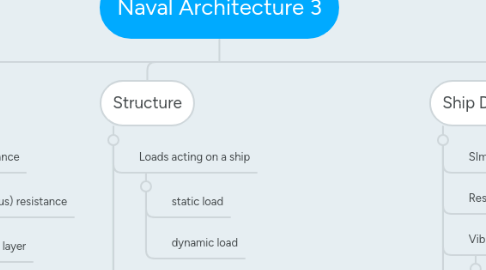
1. Structure
1.1. Loads acting on a ship
1.1.1. static load
1.1.2. dynamic load
1.2. general methods of structural analysis
1.2.1. equilibrium conditions
1.2.2. compatibility conditons
1.3. statically indeterminate structure
1.3.1. using three moments equation
1.3.1.1. 1. Find Mᴮ, Mᶜ
1.3.1.2. 2. Find resultant forces
1.3.1.3. 3. Draw shear force diagram
1.3.1.4. 4. Draw bending moment diagram
1.4. Still water loads, shear force and bending moment
1.4.1. 1. Weight curve (given)
1.4.2. 2. Buoyancy curve
1.4.3. 3. Find the load curve, q = b - w
1.4.4. 4. Shear force diagram
1.4.5. 5. Bending moment
1.5. sagging and hogging condition
1.5.1. compressopm
1.5.2. tension
1.6. Murray's method
1.6.1. 1. still water bending moment amidship
1.6.2. 2. mean weight moment
1.6.3. 3. mean buoyancy moment
1.7. Calculation of midship section module
1.7.1. Item>quantity> scantlings(bxh) > area > distance of centre from BL > area moment > Io > Ad² > I₁ = Io + Ad²
1.7.2. Yb = ∑Ad / ∑A
1.7.3. Yd = D - Yb
1.7.4. Zb = I / Yb
1.7.5. Zd = I / Yd
2. Ship Dyanmics
2.1. SImple Harmonic Oscillator
2.2. Response Amplitude Operator
2.3. Vibration of Simple Beam Variables
2.3.1. 1. Mass and stiffness distribution along the length.
2.3.2. 2. Departure from ordinary simple theory due to shear deflection and structure.
2.3.3. 3. Added mass.
2.3.4. 4. Rotary inertia.
2.4. Classification of Vibration
2.4.1. Continuous and discrete vibration
2.4.2. Deterministic and random vibration
2.4.3. Type of vibration
2.4.3.1. Free vibration
2.4.3.2. Forced vibration
2.4.4. Undamped and damped vibration
2.5. Resonance is the condition that occurs in steady state forced vibration when the exciting frequency coincide with any one of system natural frequencies.
3. Propulsion
3.1. Types of Power
3.1.1. Brake Hprse[pwer (BHP)
3.1.2. Shaft horsepower (SHP)
3.1.3. Delivered horsepower (DHP)
3.1.4. Thrust horsepower (THP)
3.1.5. Effective Horsepower (EHP)
3.1.6. EEDI Power - Energy Efficiency Design Index regulated shaft power.
3.2. Various Coeffcicients
3.2.1. Thrust coefficient
3.2.2. Torque Coefficient
3.2.3. Advance Coefficient
3.3. Interaction between Hull and Propeller
3.3.1. Wake
3.3.2. Nominal wake
3.3.3. Effective wake
3.4. Cavitation
3.4.1. A phenomenon met with in highly loaded propellers in which, beyond certain critical revolutions, there is a progressive breakdown in the flow and a consequent loss of thrust.
3.4.2. Types of cavitation
3.4.2.1. Blade tip cavitation
3.4.2.2. Sheet cavitation
3.4.2.3. Bubble cavitation
3.4.2.4. Face cavitation
3.4.3. Consequences of cavitation
3.4.3.1. The propeller efficiency will be reduced
3.4.3.2. Cavitation can cause material erosion
3.4.3.3. Cavitation can cause vibration in the propeller shafting and noise.
3.4.4. Preventing cavitation
3.4.4.1. Avoid fouling
3.4.4.2. Run at optimal speed
3.4.4.3. Correct operation of the pitch control
4. Resistance
4.1. Components of Resistance
4.1.1. Frictional (viscious) resistance
4.1.1.1. Boundary layer
4.1.1.2. Laminar FLow
4.1.1.3. Turbulent Flow
4.1.1.4. Transition region
4.1.2. Wave-making resistance
4.1.3. Eddy resistance
4.1.4. Air resistance(5%)
4.2. Ship features that influence resistance
4.2.1. Fullness of form
4.2.2. Breadth/draft ratio
4.2.3. Position of LCB
4.2.4. Shape of Design Waterline
4.2.5. Bulbous Bow
5. Manoevering
5.1. Manoeuvrability Requirements
5.1.1. Ability to run in a straight line
5.1.2. Ability to respond to the rudder quickly
5.1.3. Slow speed manoeuvrability
5.2. Testing the manoeuvrability
5.2.1. Turning Circle
5.2.2. Zig-zag manoeuvre
5.2.3. Spiral Manoeuvre
